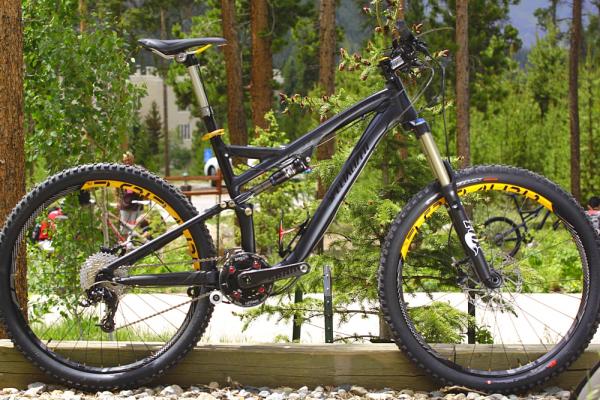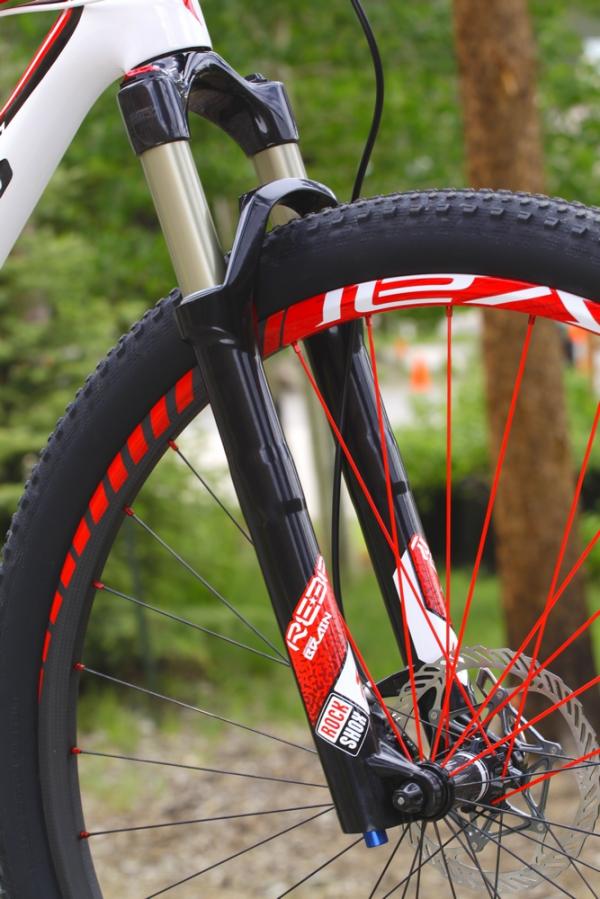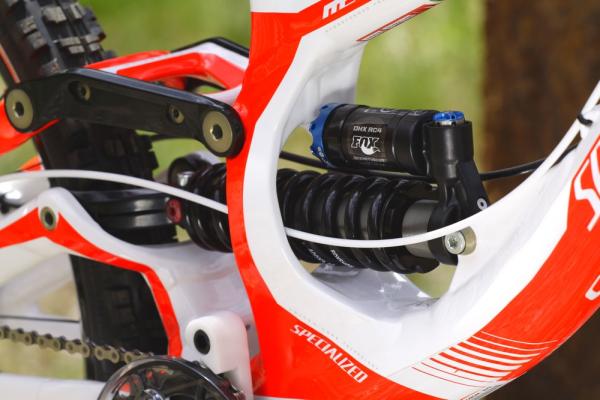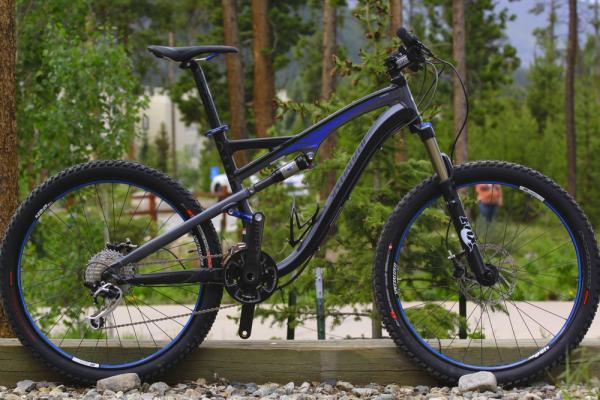Specialized 2011 mountain bike: Epic, Camber and more
Mountain bike range launched in Colorado


















Specialized launched its 2011 mountain bike line in Keystone, Colorado, with an all-new Camber 120mm trail bike, redesigned Epic, updated Safire women's model plus 29ers and a new Evo line.
The most groundbreaking of Specialized's new bikes is the Epic. While it closely resembles the 2010 bike, the 2011 incarnation is all-new. The front end of the carbon fibre frame has been reworked with a new top tube that drops last year's top tube/seat tube strut in favour of a heavily-flared aft section. This is not only lighter, but also simplifies production. Specialized has moved to a Pressfit 30 bottom bracket, citing reduced weight and compatibility with any cranks via adaptors.
At the back, the top-flight S-Works model is unique among cross-country bikes, featuring as it does a 142x12mm through-axle for the rear wheel. Wheel guides on the inner faces of the dropouts make for quick wheel changes, while Specialized has come up with special Roval wheels to work with the system. The manufacturer has maximised the flange spacing on the rear hub by taking advantage of the extra width to move the cassette slightly outboard, making for a stiffer wheel. It calls the dropout/wheel system 142+ to distinguish it from conventional (although as yet rarely seen) 142mm back ends.
Part of the motivation for stiffening the frame and wheels was to improve the ride of 29in-wheeled bikes, of which Specialized has many in the 2011 range. In the 26in Epic range, only the S-Works has the 142+ rear end (although you'll now find carbon frames down to Comp level), while it's found across the range in the 29ers. It's making a big thing about the S-Works Epic 29, which is understandable given that it's the lightest full-suspension 29er yet built at 9.66kg (21.27lb).
That's helped by the new Roval Control SL 29 wheelset, which use carbon fibre rims to drop the weight to 1,400g. Oversized end caps at the front and wide-stance spoke flanges boost stiffness, with the 142+ rear wheel claimed to be 20 percent stiffer than the previous top-end Roval 29er wheels. All this tech finds its way into the Control SL 26in wheels too, with a weight of 1,200g and even more startling stiffness gains.
While the Specialized/Fox Mini Brain inertia valve shock is still present at the rear, and Specialized's own E100 fork still graces the front of the high-end 26in bikes, the 29ers and lowlier 26ers get a new RockShox Reba S29 fork that includes a Brain valve. This is the first time that Specialized has carried out this kind of development with a suspension manufacturer other than Fox.
You'll also find double-ring chainsets across the Epic ranges, a feature that's very prominent in the 2011 Specialized range as a whole. With 10 speed cassettes available across the board from SRAM and Shimano for 2010, Specialized has taken the decision to use doubles wherever it can, tuning the choice of rings to suit the intended use of the bikes.
The latest race content, interviews, features, reviews and expert buying guides, direct to your inbox!
You'll find 24/38 doubles across the Stumpjumper FSR and Enduro ranges, for example. Those bikes see few fundamental changes. The Specialized S140 fork on high-end Stumpjumpers has been retuned, and now won't feature a Brain inertia valve. The Enduro's E160 fork has also been fiddled with internally, while the 160mm travel all-mountain bike gets a new custom RP23 shock.

Specialized Epic S-Works 29er
Rather than a choice of settings with ProPedal on, the shock has a fixed 'lots of pedalling' setting and a choice of three levels of compression damping with the lever in the off position. Super-plush rear suspension is a wonderful thing, but many riders favour something a little pingier – if you like to jump, a back end that doesn't swallow lips and launchpads is a boon.
The Stumpjumper FSR's move to 140mm travel in 2010 left a considerable gap between it and the 100mm Epic. For 2011 that gap's been filled by the all-new Camber. It's a 120mm travel trail bike (or 100mm in its 29in incarnation) that will occupy a range of price points starting below the Stumpjumper FSR range, but overlapping with it – the top-end Camber will be more expensive than the entry-level Stumpjumper.
The Camber is similar to the Stumpjumper in terms of geometry, but in a shorter-travel package. The all-aluminium frame uses integrated hydroforming, with the pivot locations being formed with the tubes rather than being separate welded-in forged sections. You also won't find any Brain shocks – Camber is all about simplicity. The top-end Pro models feature a custom SRAM carbon double crank, with triples on the cheaper bikes.
Big-wheel fans will also be interested in the new Stumpjumper 29er hardtails. With race wins at Sea Otter and TransGermany, and a World Cup podium spot, these may be the 29ers to convert an often-sceptical audience. They boast short chainstays and wheelbases and, importantly, low weight – the carbon 29in frame comes in at 1,049g.
That frame features hollow dropouts, a Pressfit 30 bottom bracket and takes a 27.2mm seatpost for extra comfort. All these features are also found in the 26in Stumpjumper HT frame, with a claimed weight of 920g.
Specialized has had an extensive women's range for several years, and there are several developments for 2011.
First, there's an all-new Safire full suspension bike. To improve suspension performance, the Safire has moved to the in-line shock position found on the Epic and Stumpjumper FSR, with the shock oriented in line with the seatstays. That presented a conflict with a desire for lower standover height, but one that was neatly solved by mounting the shock in a forged pocket midway along the top tube.

Specialized Safire
By effectively tucking the shock up inside the top tube, standover height is claimed to be the lowest of any 120mm bike. The revised rear suspension is optimised for the lower shock pressures used by typically lighter women riders, with different rate curves compared to Specialized's men's bikes.
The Safire's cunning top tube construction is also found on the 100mm travel Myka FSR. Specialized's ever-expanding 29er range extends to women's bikes too, with a 29er Myka hardtail that, impressively, comes in a range of sizes to fit riders from just 5' tall.
Having already appeared at World Cup races (and in various photos and videos on the internet), the 2011 Demo will already be known to many. Geometry is carried over from the previous bike, but the new Demo is lower-slung, with a shorter head tube and lower centre of gravity.
While the rear dropouts take a wide 150x12mm rear axle, the chainstays and seatstays are narrower for improved heel clearance, with wide, flat-pedal-friendly shoes. At 3in, shock stroke is slightly up on 2010 with a lower leverage ratio.

Specialized Demo
The whole frame is also smoothed out, with potential mud-collecting pockets eliminated. There'll be no Demo 7 for 2011 – it'll be replaced by a new 180mm travel SX Trail.
Specialized's final clutch of new bikes is the Evo line. These are pumped-up versions of other bikes in the range – there's an Enduro Evo with a Fox DHX coil shock, a Stumpjumper FSR Evo with 150mm travel front and rear, a chain guide, wider bars and bigger tyres, and even an Epic Evo with a 120mm fork. As if that wasn't enough, there are less-is-more race-oriented Evo R variants of the Epic and Stumpjumper HT, with 1x10 drivetrains and custom chainguides.
Ready to hit the road with top-tier equipment? Check out our Specialized coupon codes for great deals on bikes and accessories.